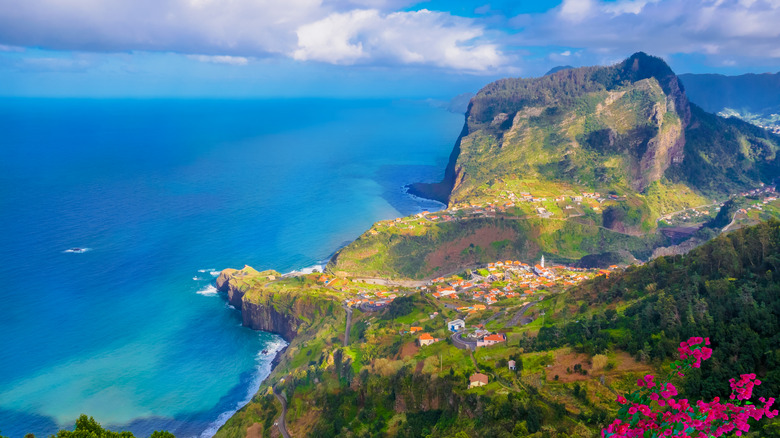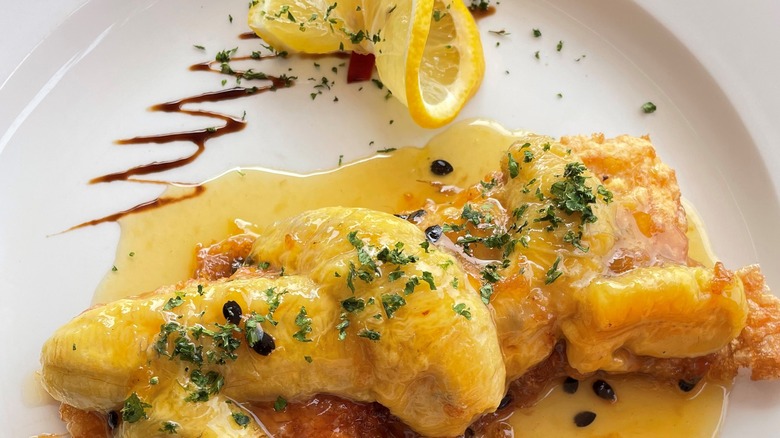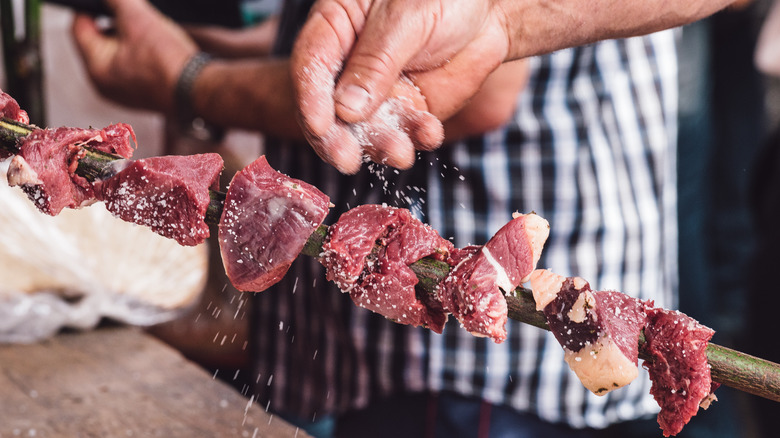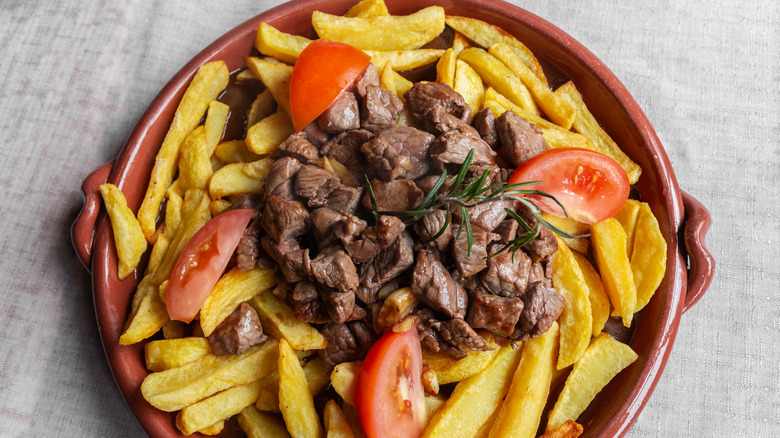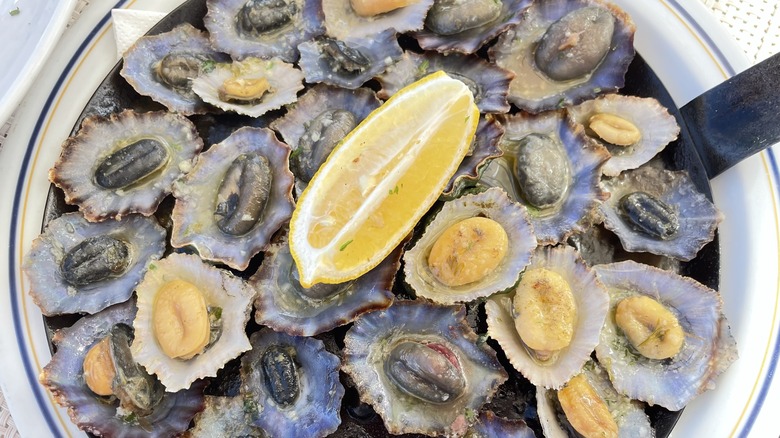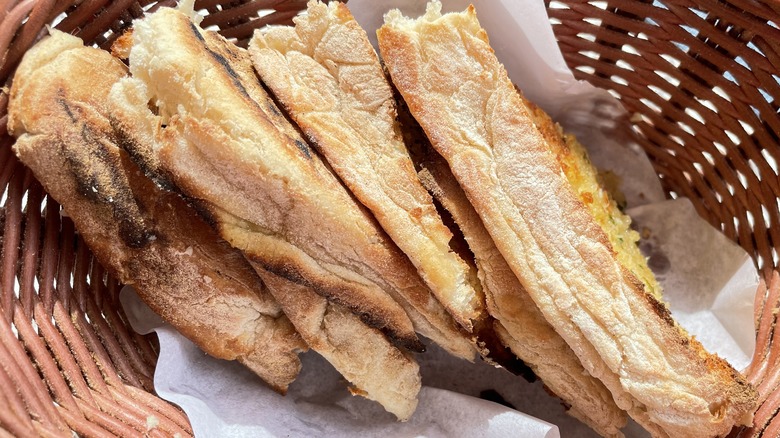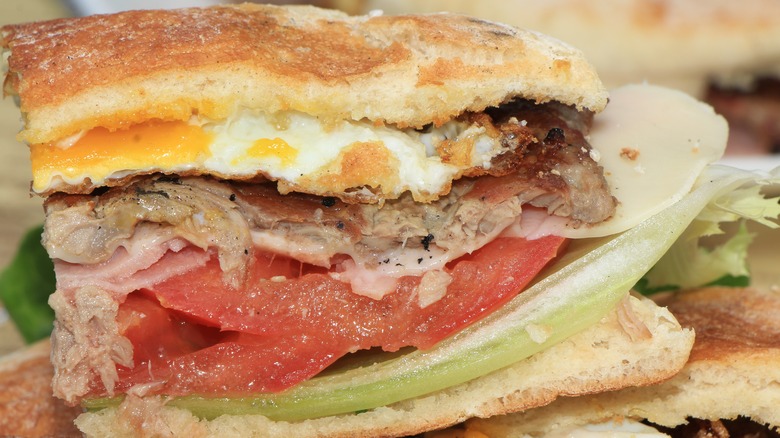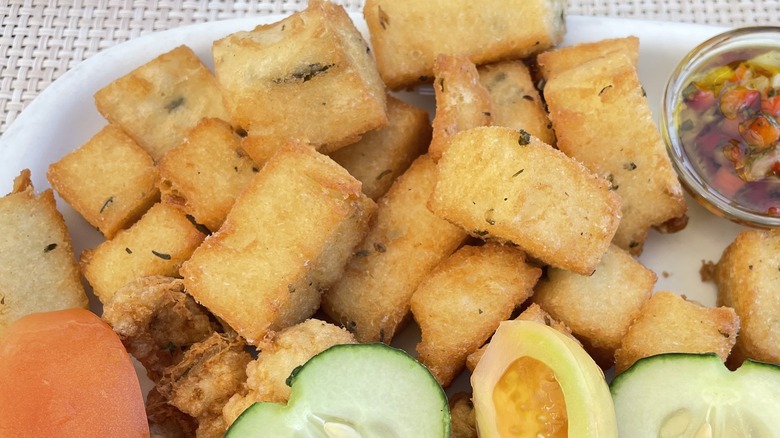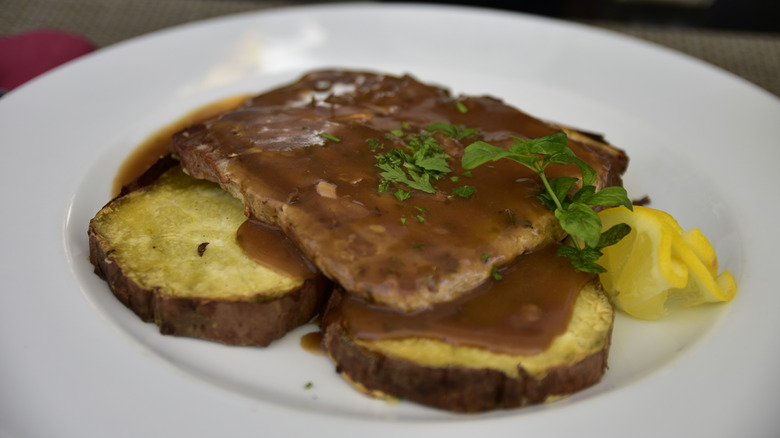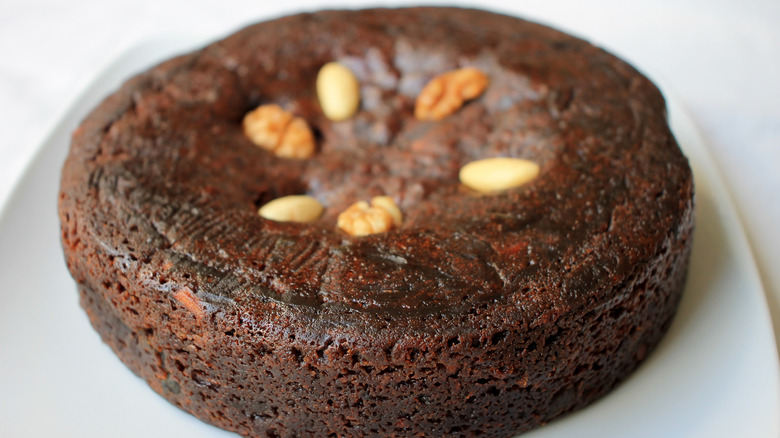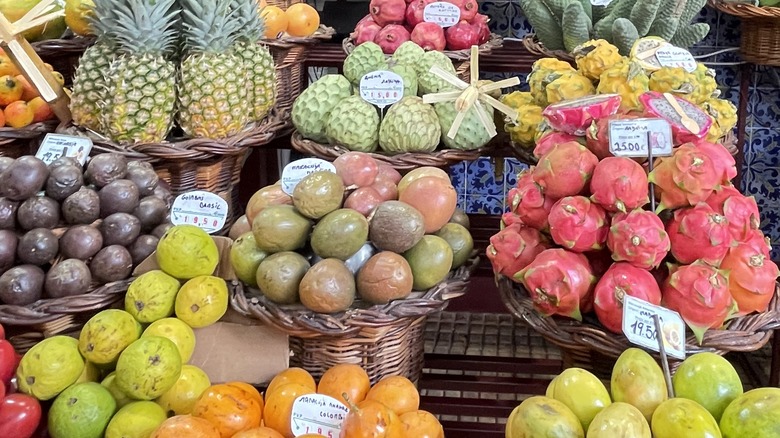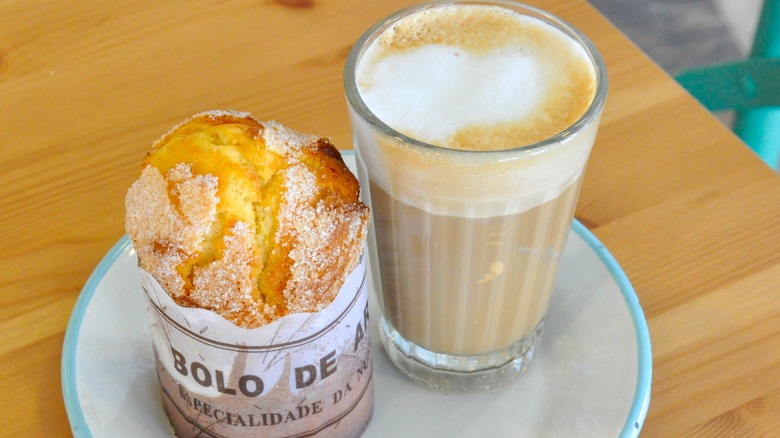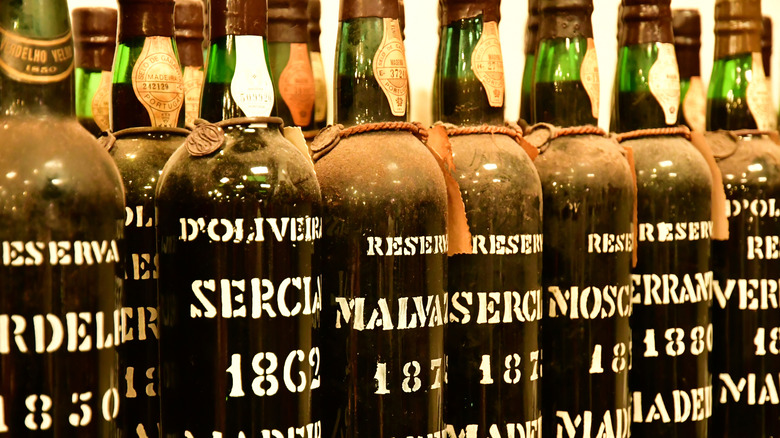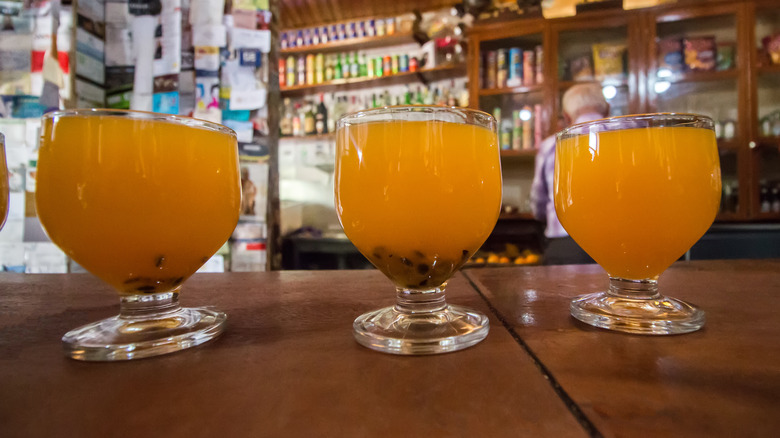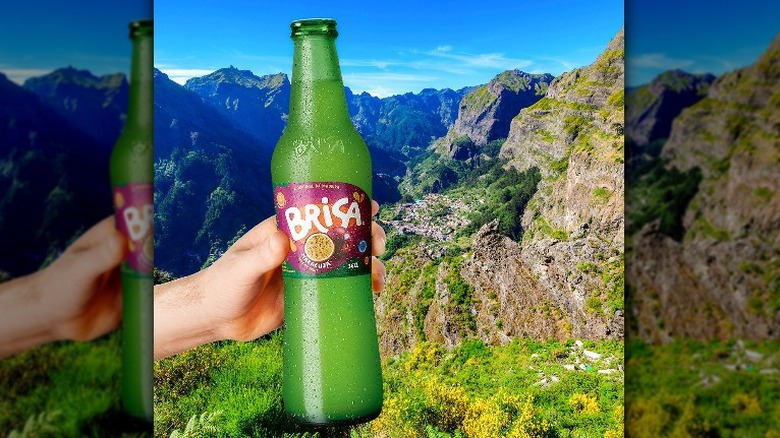14 Foods And Drinks You Need To Try In Madeira, Portugal
The island of Madeira is one of the two autonomous regions of Portugal situated in the North Atlantic Ocean. The island lies in the region of Moroccan shores and therefore has a subtropical climate, notes Visit Madeira. Madeira became known centuries ago for its fortified wine, but its food and drink landscape is much more complex.
With more than 500 years of history, Madeira has been an important commercial hub, sugar cane provider, agricultural hub, and a sought-after tourist destination. Today, the island is home to a unique protected forest, the Laurisilva, jagged mountain peaks, volcanic beaches, and lush tropical vegetation, says the World Heritage Convention. It also offers a particular mode of trekking inside the Laurisilva, with paths laid alongside levadas, a system of irrigation built by early Portuguese settlers. Madeira's cuisine and drinks bear the mark of what the island offers from an agricultural and geographical perspective, with bay leaf flavors, banana and passionfruit dishes, and sugarcane-based beverages. Here are some of the best foods and drinks in Madeira.
Black scabbardfish fillet with banana and maracuja
Espada with banana is a dish you can find in almost every restaurant in Madeira. Locals came to consider it one of the most representative dishes on the island, alongside the similar-sounding espetada, which is very different, namely beef grilled in a skewer. Due to the island's geography, the espada is a representative fish in Madeira. A deep-water predator, black scabbardfish lives and hunts at a 2,000 to 5,000 feet depth. Madeira is a volcanic island, meaning the Atlantic's depth around the island drops quickly. For this reason, local fishermen could catch black scabbardfish close to the shore. When they found that the wide-eyed, toothy sea monster had a delicious flavor, black scabbard fish became a staple food in Madeiran cooking.
The combination of espada with fried banana is a modern dish that caught on thanks to the large banana plantations in Madeira. Of all the different banana types, most bananas grown in Madeira belong to the Dwarf Cavendish variety, a sweet-tasting small banana. The dish has a fried and salty taste, combined with the sweetness of the banana. Many restaurants serve it with a maracuja sauce, which is tangy, acidic, and perfect for adding to the combination. Marina Azul restaurant in Calheta harbor serves the dish, and it is an authentic taste and flavor explosion from the first to the last bite.
Espetada
Another typical Madeiran dish is espetada, grilled beef on laurel skewers seasoned with garlic, salt, and bay leaf. The essence of this dish, laurel, is why the Portuguese first colonized the island in 1419. Madeira has dense laurel forests called Laurissilva (also referred to as Laurisilva), a reminiscence of prehistoric forests. These forests represented part of the source of wood used to build the Portuguese fleet. Even today, as you stroll a typical hiking path called a levada, the forest smells like bay leaf.
So, as cows are some of the best-adapted farm animals to the mountains in Madeira, it's only natural that a representative dish on the island would be made with beef and flavored with laurel bay leaves. Furthermore, the laurel skewers which hold the meat in place also add to the flavor, as they carry the same wood-like, sweet taste of bay leaves (bay leaves are the leaves of laurel trees). Finally, garlic completes the seasoning for espetada, leading to a very inspired combination. The flavors (beef, bay, leaf, and garlic) are intense and belong to the earthy and wooden categories.
Picado
Picado is a Madeiran appetizer with a flavor similar to espetada but milder. For this dish, beef is not grilled but cooked in a rich and creamy sauce. It is usually served as a shared dish, surrounded by French fries. As it's a sharing dish and appetizer, picado can be eaten with a toothpick or scooped on individual plates and eaten with a knife and a fork. A traditional food, picado is a dish for social gatherings in Madeira. There are also octopus and squid picado versions which are prepared differently, as laurel bay leaf and garlic tend to overpower the delicate taste of seafood.
Many restaurants in Madeira serve simple foods, which you can enjoy as quick bites. Such is the case with Lounge Bar Clube Naval do Seixal, a small restaurant located near Seixal beach, one of the most spectacular beaches on the island. Specializing in cocktails and quick bites, the restaurant serves different local dishes, including picado. The beef picado comes with a thick, savory sauce. It is flavored with bay leaf, garlic and butter and comes with a generous portion of fries. On the other hand, the octopus picado dish comes with a milder sauce, flavored with garlic, but with a softer aroma.
Limpets
Madeira is a great place to try limpets, an aquatic snail species that lives on the rocky shores of Western Europe. They are usually grilled and seasoned with garlic and butter and have a specific sea flavor and a smooth texture. They taste like a combination of mussels and clams. Limpets are an appetizer in most Madeiran restaurants. Porto Santo, a small fishing village, even celebrates the Limpet Festival, which takes place in the middle of July and promotes local gastronomy and traditions.
Restaurante Orca in Porto Moniz serves typical garlic-flavored limpets. The dish comes in a pan, adding to the authenticity of the presentation. Like many other types of seafood, limpets are not necessarily filling, but they give a pleasant taste of the ocean, perfect for opening an oceanside meal. With a few drops of lemon juice, they are the ideal salty, sea-flavored, tangy treat as you gaze upon waves crashing on the shore.
Bolo de caco
Bolo de caco is the local variety of bread. It's also solid proof that Madeiran cuisine has very different influences, resulting from the constant contact between locals and travelers or commercial ships. Bolo de caco is a dish of Arabic descent, a type of bread prepared with wheat flour, yeast, water, and salt. The dough is shaped into round, flat pieces and then baked on hot stones or metal stoves. The resulting bread has a firm outside crust and a soft interior, but it is less spongy and soft than many other types of bread. Although it has become a staple of Portuguese cooking, bolo de caco originates from Madeira.
The dish is integrated into local cuisine as profoundly as any bread belongs to Western eating habits. However, Madeiran restaurants serve bolo de caco in two different ways. First, it can be an appetizer. As garlic bread, it is toasted and covered with a thick layer of garlic butter. As a sandwich bread, it is firm enough to hold the sandwich ingredients and soft enough to soak in the many delicious sauces that accompany the meat in sandwiches.
Prego sandwich
A sandwich made with bolo de caco, the Prego sandwich is another typical food in Madeira, notes Madeiramazing. For this sandwich, the bread is grilled and then smeared with garlic butter. Then, the bread is covered with a slender slice of beef steak, prepared in the typical Madeiran way, with garlic and bay leaf, cheese slices, ham, lettuce leaves, and a tomato slice. Some prego sandwich varieties also include a fried egg. The bread soaking in the cooking juices of the steak is the best part of this sandwich.
An alternative way of making this sandwich is to pound the garlic slices into the meat using a tenderizing mallet. This preparation method ensures that when the steak is fried in melted butter, the garlic will fry alongside it and flavor the meat while cooking. In addition, caramelized onions accompany the garlic steak. Their flavors mix and become richer by cooking them together for a few minutes. Then, the onion-steak mix is added to the buttered bolo de caco, resulting in a dish that is filling and full of flavors. Talk about the art of the sandwich!
Milho frito
Milho frito, or fried cornmeal, is another typical Madeiran dish. As corn is the essential cereal cultivated on the island, says Madeira Web, it's only natural to use it in food meant to accompany meat and fish. What's typical to milho frito is mixing the white cornmeal with thinly sliced greens (kale is preferred), giving it a fresh taste and enriching the cornmeal's earthiness. Although they can seem similar, white cornmeal is different from cornstarch. While cornstarch results from the middle of the kernels, cornmeal uses the entire corn kernel.
Milho frito is prepared just as regular cornmeal by whisking the cornmeal into the boiling water in a steady stream. Next, oil, garlic, and salt are added to the boiling water to make the dish more flavorful. The greens are added when the cornmeal thickens. Any flavored leafy vegetable can be used instead of kale, but keep in mind that it will lend its aroma to the entire dish, as cornmeal has a neutral taste, even when fried. Then, the mixture is baked for almost two hours, cut into cubes, and fried (sometimes in lard). The resulting dish can be a filling snack or a side for espetada or other local foods. With its outside crispy texture and soft, flavored interior, milho frito goes well with any grilled or fried food.
Tuna
Madeira is an excellent destination for tuna fishing, with lots of tuna varieties swimming in the waters surrounding the island. Tuna is so popular that the island even hosts a festival dedicated to the dish called the Tuna Route Festival. It takes place every summer in Porto Santo and aims to showcase how tuna fishing influences the island's life, economy, and gastronomy.
Madeiran-style tuna cooking differs significantly from the usual tuna, seared on the outside and raw inside. Instead, the fish must marinate for at least three hours before cooking. The marinade mixes bay leaves, garlic, olive oil, vinegar, white wine, and oregano. The tuna is then fried in oil, and the marinade is turned into a sauce by heating it and adding some flour or a crushed tomato. The tuna can be as well-done as you prefer, but most restaurants serve it in thin, well-done slices covered in marinade sauce. Madeiran-style tuna is delicious with gravy, milho frito, potatoes, or rice.
Bolo de mel de cana
A traditional dessert in Madeiran cuisine, bolo de mel de cana is a delicacy usually made for Christmas. The name translates as "sugar cane honey cake." Its main ingredient is sugar cane honey, as stated by the name. At the beginning of the colonization process, sugar cane cultivation was intensive on the island, and in the 16th century, Madeira was the largest sugar exporter in the world. Nowadays, Madeira's sugar cane processing factories produce cane syrup, molasses, and rum.
Although it is a traditional Christmas dessert, bolo de mel is available all year round. You can store the cake for a long time, as it does not harden or spoil. Bolo de mel contains yeast, flour, and molasses. It has a crumbly texture and is soft, sweet, and somewhat reminiscent of gingerbread. The molasses gives it a lovely taste and a moist texture. The flavors combine the taste of anise, cinnamon, cloves, almonds, orange peel, and lemon. Sometimes, Madeira wine is also used to flavor bolo de mel. The cake tastes wonderful when served with Madeira wine or Madeira-made rum.
Tropical fruit (maracuja)
With its sub-tropical climate, it's no wonder that Madeira is the place where you can find various tropical fruit all year round. The farmer's market in Funchal, Mercado dos lavradores, is both a commercial venue and a tourist attraction due to its incredible local architecture and appealing local product presentation. There are countless fruit and vegetables, local and tropical flowers, spices, and fish. Try a ripe monster fruit with its sweet, grape-pineapple aroma, a buttery, nut-flavored avocado, one of the countless banana types, or a sweet, creamy anona.
The highlight of the fruit market remains maracuja, also called passion fruit. The farmers sell different maracuja varieties and offer samples so that the customers will know what they are buying. The easiest to recognize is the purple maracuja, in which the characteristic flavor combines with a tangy taste. There is also the lemon maracuja variety, which has a slightly citrusy taste. Banana maracuja has the same aspect as a small banana and tastes sweeter. Finally, the sweetest maracuja variety is the orange maracuja. It has the most robust flavor, a burst of maracuja taste, orange flavor, and sweetness. When you buy, the farmers explain how to see if the passion fruit is ripe and how to store it to preserve its best taste.
Bolo de aroz
Bolo de aroz is a traditional Portuguese dish that can be consumed either for breakfast or as a dessert, says Taste Atlas. Eating some pastry for breakfast is common in Portugal, and probably the best example is the delicate, custard-filled pastel de nata. But, whereas pastel de nata is very sweet due to the custard and the sugar topping, bolo de aroz balances out the sweetness with its lemon flavor and offers the surprising texture of rice flour.
You can find bolo de aroz in most bakeries in Madeira and local markets, such as the ever-present Continente. These pastries are a cross between muffins and cupcakes, made with wheat, rice flour, eggs, and butter and flavored with lemon and lemon zest. They are less spongy than a muffin and have a rougher texture, as rice flour absorbs more moisture. After baking bolo de aroz, it is sprinkled with sugar, contributing to the rougher texture. Bolo de aroz tastes like a sweet combination of butter, sugar, and lemon zest and is perfect with a cup of milk or coffee.
Madeira wine
Madeira wine is the beverage that put Madeira on the world's enology map, and it is what the island has been famous for hundreds of years. A type of fortified wine, it became popular in the 1600s and 1700s, says Wine Folly, when ships traveling to the Americas and the East Indies stopped in Madeira. The wine tended to spoil during long sea voyages, so it was fortified with brandy. And, as the ships traveled through the hot tropical regions, the flavor became more profound as the wine was exposed to the elements. Madeira wine lost some popularity during the following centuries, but nowadays, producers on the island aim for a comeback.
The many Madeira wine types and producers share the same main traits: the wine is fortified, perfect for drinking after a meal, has caramel, peach, and orange notes, and can range from sweet to dry. Prices vary depending on the producer, the complexity of the blend, and the aging period. An attractive characteristic is that an unopened bottle of Madeira wine has a very long shelf life, adds Usual. The process happens because, during the winemaking process, winemakers still use the interaction of the wine with the elements to enhance the flavor, so they expose the wine to oxygen. That's why a Madeira wine won't go bad, even if that unopened bottle has been gathering dust for decades.
Poncha
Poncha is one of the most popular drinks in Madeira, made with rum, lemon juice, and sugar or honey, says Madeira Holiday. The fisherman's poncha has rum, lemon juice, and honey instead of sugar, and it was drunk before going out on the sea to avoid sea sickness. It is an alcoholic beverage with 16% alcohol, served in most bars, restaurants, and taverns on the island. Poncha became a Madeiran traditional drink as rum production was one of the most important traditions on the island, dating back to when Madeira was the leading sugar cane producer in the world.
Nowadays, the drink has many flavor variations, such as poncha maracuja, poncha tangerine, or poncha orange. Poncha maracuja is the most popular one. You can buy pre-made poncha or go to a bar where the bartender will prepare it with rum, lemon juice, honey, and water and stir it using a tall wooden instrument called a mexelote. Taberna da poncha da Serra de Agua is a poncha-specialized bar where you can find all kinds of poncha drinks and Madeiran rum varieties.
Brisa Maracuja
Brisa is a Madeiran soft drink brand, and its most famous product is Brisa Maracuja, the first soft drink based on passion fruit juice. The soft drink was created in 1970, and the contemporary version features the same percentage of passion fruit juice as the original one, 9%. In addition, the soft drink uses slightly carbonated water, enhancing the passion fruit flavor. The fruit pulp usually remains at the bottom of the bottle, so you have to shake Brisa before drinking it. However, the taste and color of the drink are natural, as it is free from artificial colors and aromas.
You can find Brisa Maracuja all over Madeira. However, the island hosts the only producing company, so it is hard to find in other places. You can buy Brisa Maracuja in glass bottles, aluminum cans, and plastic bottles of different sizes. The brand also produces other soft drinks with fruit, such as apples, oranges, pineapple, and lemons, but the passion fruit version is the most popular.
